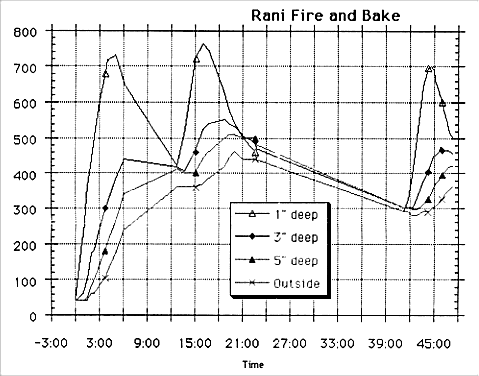Bakeoven Data
A 24 Hour Cycle in A Commercial Wood-Fired Retained-Heat Oven

The curve "IR" was obtained with an infrared pyrometer. Curve
1 is with a thermocouple probe flush with the inner surface of the brick.
For Curve 2 the probe is in the middle of the brick, Curve 3 is at the
junction of the brick and cladding, curve 4 is in the middle of the cladding,
and curve 5 is at the outer edge of the cladding, inside the insulation.
A fire was started at 0:00 hours and was partially damped with a draft
door when well established. Coals were spread out at 4:30, raked forward
at 6:30, removed at 7:00. The oven was closed from 7:30 until it was cleaned
at 9:00. Focaccia and "mini-baguettes" were loaded at 10:00,
out at 10:15, baguettes in at 10:25, out at 10:50. Three full load of loaf
breads were baked, the last out at 13:50, at which time the inner surface
of the oven was 483 F. It rose to 500 F by 15:30, and fell to 480 by 24:00.
Note that the inner surface of the brick went from 450 F to over 1100
F in 4.5 hours, but that it takes the cladding 10 hours to reach its maximum
temperature, just as the oven is loaded. That heat is therefore available
to work its way back through the mass, stabilizing the temperature of the
inner surface when it would otherwise fall steeply. When the baking and
firing schedule permits, the oven is fired a few hours earlier, reducing
the need to leave it open for a period before baking begins. Given the
final temperature of about 500 F, additional loads could also have been
successfully baked without refiring
48 Hour Cycle in a Smaller Oven with Uninsulated Floor

A 48 hour cycle in a 32 X 36 inch oven (without hearth insulation),
fired from "cold" and used to bake bread on two successive days.
The first curve is from a thermocouple 3/4" deep in the dome; the
next curves are from the middle of the brick layer, the middle of the cladding,
and the outside of the cladding, inside the insulation
A preheat fire was started at 0:00 hours; at 4:00 the door was placed.
Another fire was started at about 12:30 and burned until 15:30. Three load
of bread (12-14 loaves a load) were baked from 18:30 to 22:00. It was refired
at 41:00 and 3 loads of loaves were baked by 47:30. (The oven was a little
too hot but the first loaves were fully proofed and could not wait.)
Note that from 19 - 22:00 hours the falling temperature of the inner
masonry is being stabilized as heat is recovered from the deeper masonry.
Also note that even two firings 12 hours apart are not enough to bring
the entire mass of this oven to a temperature that is above that required
of the baking bread; the mass is never fully heated. The smaller size of
the oven (greater surface to mass and/or volume ratio) and a lack of hearth
insulation probably account for its more rapid loss of heat, compared with
the Weber oven, even accounting for the 2:1 ratio of time constants in
the graphs.
Contact: Dan Wing
|


![]() Heat-Kit
Heat-Kit
![]() Bakeoven
Page
Bakeoven
Page ![]() Gallery
Gallery
![]() Links
Links
![]() Library
Library
![]() Current
Projects
Current
Projects